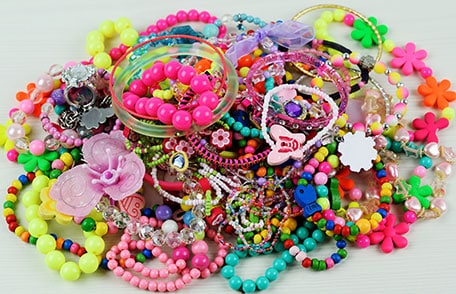 Protect children from exposure to lead in metal and plastic toys, especially some imported toys, antique toys, and toy jewelry. Childhood lead exposure is preventable.
Protect children from exposure to lead in metal and plastic toys, especially some imported toys, antique toys, and toy jewelry. Childhood lead exposure is preventable.Many children get toys and toy jewelry as gifts during the holiday season. Some toys, especially some imported toys, antique toys, and toy jewelry may contain lead. Although lead is invisible to the naked eye and has no smell, exposure to lead can seriously harm a child’s health. Young children tend to put their hands, toys, or other objects―which may be made of lead or contaminated with lead or lead dust―into their mouths. If you have a small child in your household, make sure the child does not have access to toys, jewelry, or other items that may contain lead.
Lead in Toys
Lead may be found in the paint, metal, and plastic parts of some toys and toy jewelry, particularly those made in other countries, and also antique toys and collectibles.
- In 2008, the Consumer Product Safety Improvement Act (CPSIA) pdf icon[PDF – 118 KB]external icon was signed into law, requiring toys and infant products to be tested to mandatory standards before being sold.
- The use of lead in plastics has not been banned. Lead softens plastic, making a toy more flexible to return to its original shape. Lead may also be used in plastic toys to stabilize molecules from heat.
- Lead dust can form on toys when some plastics are exposed to sunlight, air, and detergents that break down the chemical bond between the lead and plastics.
- Lead also may be combined with other metals, such as tin, to create alloys that are used to make toys.
To reduce children’s risk for lead exposure, the U.S. Consumer Product Safety Commission (CPSC) tests and issues recalls of current products that may potentially expose children to lead. Check the CPSC websiteexternal icon or call 1 (800) 638-2272 to be sure your child’s toys are safe. You can find photos and descriptions of currently recalled toys on that website. For additional information on lead in toys, visit the CDC Lead website.
Only a certified laboratory can accurately determine how much lead is in a toy. Although do-it-yourself kits indicating the presence of lead are available, they do not show how much lead is present and their reliability at detecting low levels of lead has not been determined.
What should I do if I am concerned about my child’s exposure to lead in a toy?
If you think your child has been exposed to a toy containing lead, or if your child has a recalled toy, take away the toy immediately and contact your child’s healthcare provider. Most children who are exposed to lead have no symptoms. A blood lead test is the easiest way to find out if your child has been exposed to lead. Your child’s healthcare provider can help you decide whether a blood lead test is needed and can recommend appropriate follow-up actions if your child has been exposed. As levels of lead in the blood increase, adverse effects from lead may also increase.
To be sure your child’s toys are safe, check the Consumer Products Safety Commission list of recalled toysexternal icon.
|
To be sure your child’s toys are safe, check the Consumer Products Safety Commission list of recalled toysexternal icon. |
Lead in Toy Jewelry
What are the effects of wearing toy jewelry?
Just wearing toy jewelry that contains lead will not cause your child to have a high level of lead in their blood. However, chewing, sucking on or swallowing toy jewelry that contains lead will expose your child to lead. Make sure children in your home do not have access to jewelry or other items that may contain lead.
What should I do if I think my child put lead jewelry in his or her mouth?
If you think your child put jewelry containing lead in his or her mouth, take the jewelry away from your child and contact your child’s healthcare provider. Your child’s healthcare provider can help you decide whether a blood lead test is needed and can recommend appropriate follow-up actions if your child has been exposed. Many private insurance policies cover the cost of testing for blood lead, and blood lead testing for children enrolled in Medicaid is covered by the Centers for Medicare & Medicaid Services (CMS). For additional information on local resources, contact the childhood lead poisoning prevention program in your area. If your state’s resources are not listed on this website, contact your local or state health department.
No safe blood lead level in children has been identified. Even low levels of lead in blood have been shown to affect IQ, the ability to pay attention, and academic achievement.
The good news is that childhood lead exposure is preventable.



